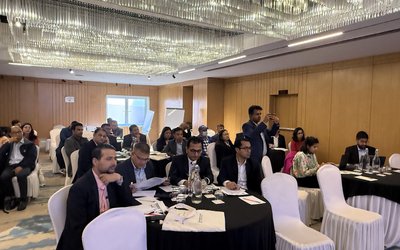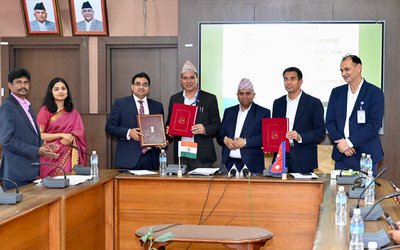
Going to the digital and cashless payment system at all levels of government, public and private businesses are the only way to fight corruption in Nepal. While, I do not see any leader that has any intention (let alone the vision) to fight against rampant corruption in Nepal, I cannot stop myself being optimistic. A payment is simply understood as the transfer of value from one party to another either to exchange goods and services or to fulfill a legal or contractual obligation between the parties for good and services. The first form of payment we learned from the history is the barter system which involves exchanging of a good or service for another. Even today, this system is prevalent in many societies throughout the world. Nonetheless, recently, the most common payment method involves the use of cash money, cheque, credit or debit cards, bank transfers, stocks and shares.
The Bitcoin, a cryptocurrency, is one of the latest systems for payment. Even though the meaning of payment looks simple, the transfer of payments is an extremely complex industry. Yet, trends have clearly shown that the business opportunities for the next few decades lie largely on digital transaction and electronic transfers for businesses, both of the public and private sectors. It has already been seen that individuals are gradually developing confidence in using their smart phones for all kinds of formal and information transactions including shopping at stores, shopping online and paying rent among other things. It is very uncommon in many countries for governments and businesses to digitally pay their employees and clients. With innovation in smart household devices from refrigerators to smart watches, we now have features with payment capabilities that may change the consumer's behaviour dramatically. Similarly, blockchain (database) technologies such as Bitcoin (electronic money), currently in its infant stage, could bring about a paradigm shift in how consumers and digital payments would be carried out.
The future of digital payment will depend on how the traditional debit and credit processing chain will change along with the role that acquirers, processors, banks, card networks, sales organizations as well as software and hardware developers and suppliers may play. Payments for goods and services is about transferring monetary information from one person, business or party to another person, business or party. When a digital transfer occurs, there is an evidence of the transfer in some way through the financial institution (bank, credit unions etc) which facilitates the transfer. There are a number of advantages of the digital/cashless payment system. The cashless payment system is secured through regulated financial institutions such as banks.
As all payments made on-site are processed digitally, this simplifies operations and reduces time and staffing costs for businesses and the government. There is no need to count money or weigh tokens, or good. All on-site purchases are instantly recorded digitally and are always tractable as and when needed. In many developed nations of the world (US, Canada, Mexico, Brazil, UK, Australia, European Union etc) people can use an entirely digital payment system. There is no need to carry cash anywhere. Groceries, clothing, automobiles, computers and virtually anything can be purchased without cash at hand. Every transfer has a clear record of the amount, time, senders and receivers. In Canada, if someone transfers more than a certain amount ($1000 or more), a government issued photo identification is required which is linked to the national identification number every citizen has. This allows the government authorities to more effectively track the transfer of funds and investigate if required even after several years.
Recently, the Central Government of India has decided to go cashless in all form of payments. The government has also announced a number of discounts measures for consumers who pay digitally (eg: 0.75 % discount on petrol and diesel pumps, 0.5 % on railway tickets, 8-10% in life and general insurance, 10% discount on highway tolls, no tax on transactions up to Rs. 2000 etc). The government is also investing a huge amount in digital infrastructure in rural areas. The Central Government will provide financial incentives to the eligible banks to deploy two POS ('Point of Sale': machines capable of scanning barcodes and printing receipts) digital machines in one lakh villages with less than 10,000 population. These digital machines are intended to be deployed at primary cooperative societies/milk societies/agricultural input dealers to facilitate agri-related transactions through digital means. This measure will provide benefits to farmers of one lakh villages with a total population of nearly 75 crore as they will have facility to transact cashlessly in their villages for their agriculture needs.
The whole principle behind digital payment is that all transfers are tracked and thus nobody can hide their sources of money or whether they have spent their money, which will give the government ammunition for tax collection from all eligible sources and curb on black money or funding to unintended organization. In Nepal, there are neither laws that state the requirement for digital payment systems not sufficient digital infrastructure to carry out digital payment at all level of businesses. When the transfer of money takes place in the form of cash, it is very hard to track where the money came from, what the source of the money was and whom it was transferred to.
There may not be any trail of such cash transfers until a receipt is issued. This is even worsened when printed fake receipts and bills are available in retail stores with no tax links and used as a proof. That is where money mismanagement and corruption starts. Even the government organizations accept such fake receipts, which is ridiculous. Recent cases where series of Chief of Armed Police force in Nepal prepared fake bills and embezzled billions of tax payer’s rupees is a vivid example of corruption which could never have happened if the government offices have gone to digital payment system. May millions of such cases happening in Nepal daily and the government neither has intension nor vision to tackle rampant corruption in Nepal. No fake receipts will be accepted when a digital system is implemented.
No tax hiding can take place from persons and businesses; there can be no reduction in land prices to avoid the land transfer tax. Businesses cannot avoid taxes, shopkeepers cannot write fake bills/invoices, corporations and NGOs cannot also hide where their money is being spent. This will also be instrumental in tracking the illegal donations to political parties and party leaders. In order to stop the corruption in Nepal, the government must prepare itself to go to digital payment in the next three to five years. It will take this long to develop digital infrastructures such as meeting energy infrastructures in various parts of the country. With the advancement in digital and information technology, Nepal can dramatically transform itself in the way the government and the public/private businesses are being run. Its importance will be even greater if Nepal ever implements the federal system, under which the tax system could be much more complicated.















